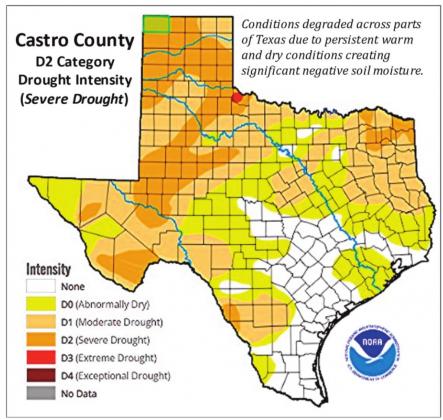Drought conditions are worsening in the Texas Panhandle and South Plains regions, including Castro and other surround counties.
Castro County is now in the Severe Drought (D2) stage, according to the most recent Drought Monitor map on Dec. 7.
Drought conditions expanded and intensified on the map in areas of the South including Louisiana, Arkansas, and Texas as well as in the Southern Plains of Oklahoma, where overall warm and dry conditions have prevailed during the past 30- to 120-day period.
Conditions degraded across much of the region including Texas, Oklahoma, Louisiana, and Arkansas where areas of Moderate Drought (D1) and Severe Drought (D2) expanded in response to persistent warm and dry conditions.
In the western portions of Oklahoma and Texas, the NASA Crop-CASMA application is showing significant negative soil moisture anomalies this month. In the Rolling Plains of Texas, some droughtrelated impacts have been reported, including reports of winter wheat crops continuing to struggle due to the lack of moisture.
Conditions are drying around much of Texas, and forecasts are calling for winter weather to be warmer and drier than average.
Commodity producers in much of the state, including the High Plains, experienced a banner year in 2021 due to high commodity prices and above-average precipitation that started in May and delivered timely moisture throughout the growing season.
But soil moisture levels are declining in parts of the state, and the 2022 growing season could hinge on winter weather replenishing topsoil and subsoils or another round of timely summer rains to save the day.
Jourdan Bell, Ph.D., Texas A&M AgriLife Extension Service agronomist, Amarillo, said drought conditions are expanding throughout the High Plains. The region has not received significant precipitation since September while aboveaverage temperatures were exacerbating soil moisture level declines.
The U.S. Drought Monitor shows most of the High Plains, West Texas and East Texas are in extreme drought to abnormally dry.
A strong La Niña weather pattern is expected this winter, which often means less rainfall and warmer temperatures for the Southwest, including much of Texas.
With most of the cotton and other crops harvested in the region, the area is beginning to concentrate on winter wheat and feeding cattle. The dry conditions are not helping the winter wheat conditions. Rangeland and pastures are dormant and supplemental feeding is occurring.
“Soils are drying out and that is definitely a concern moving into winter and spring,” Bell said. “We continue to hear that weather conditions are expected to be warmer and drier than average, so limited soil moisture could be drive 2022 cropping decisions in water-limited regions.”
Bell said producers in the High Plains are making serious evaluations of input costs due to high fertilizer prices and pesticide shortages despite strong commodity prices. But much of the planting decisions will be based on precipitation received between now and planting and how well soil moisture indexes recover from drought winter conditions. Dryland and limited irrigated producers will likely select crops that tolerate moderate drought conditions.
But winter is typically a dry period for the High Plains region, Bell said. Much of the restorative rainfall events historically occur during monsoon season in late summer through September.
The region does typically pick up some winter moisture from snowfall, Bell said. While snow represents important moisture and an insulator against extreme cold for winter crops like wheat and canola, the moisture from snow is only a fraction of rainfall’s liquid equivalent.
“A few inches of moisture are important when you are in a 16-24-inch rain zone like the Texas High Plains, but we are going to need good spring rains to help reduce the current rainfall deficit and improve the overall topsoil and subsoil moisture index,” she said.

